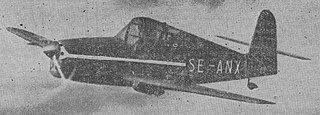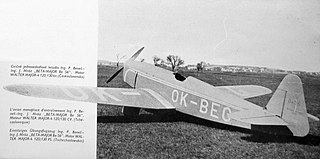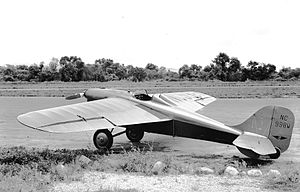
The SAI KZ III Laerke was a Danish light utility aircraft used by the Danish Air Ambulance Service and Danish Air Force.

The Vultee XA-41 was originally ordered as a dive bomber. After combat experience led the Army Air Corps to believe dive-bombers were too vulnerable to enemy fighters, the contract was amended to change the role to low-level ground attack. Although the XA-41 was a potent weapons system, the design was overtaken by more advanced technology, and never entered production.
The Aeronca Model 9 Arrow was a low-wing all-metal cabin monoplane with retractable landing gear. It was marketed to returning pilots from World War II and unveiled in 1947 but never went into production.

The Auster J/4 was a 1940s British single-engined two-seat high-wing touring monoplane built by Auster Aircraft Limited at Rearsby, Leicestershire.

The Albatros L 75 Ass was a German trainer biplane of the 1920s. Of conventional configuration, it seated the pilot and instructor in separate, open cockpits. The wings were single-bay, equal-span, and had a slight stagger. Production continued after Albatros was absorbed by Focke-Wulf.

The All American 10A Ensign was a two-seat light plane built in the United States shortly after World War II. It was a low-wing, all-metal cantilever monoplane with fixed tricycle undercarriage and which seated its pilot and passenger side by side under an expansive bubble canopy. Due to the glut of military surplus aircraft on the civil market after the war, All American was unable to attract buyers and no production ensued.
The Auster Avis was a four-seat light aircraft developed from the Auster Autocrat. It featured a redesigned fuselage incorporating four doors and a circular cross-section towards the tail, new undercarriage, and new wing flaps. It was planned in two versions, the Mk 1 for civil use, and the Mk 2 for military and air ambulance duties. However, only two prototypes were built, and Auster abandoned the project in favour of the Auster J-5 Autocar.

The Fokker F.25 Promotor, first flown in 1946, was a single-engined, twin-boomed, four-seat passenger monoplane with a pusher engine mounted at the rear of a central nacelle. It was of wooden construction and has fitted with a retractable nosewheel undercarriage. One feature of the design was that instead of a 2 + 2 seating, the pilot sat in front to the left, and all three passengers were on a bench seat to the rear of him. Alternatively, when being used as an air ambulance aircraft, it could carry a patient on a stretcher, which was loaded through a hatch in the aircraft's nose. The F.25 was evocative of the pre-war G.I design.

The Colonial Model C-1 Skimmer was an American small single-engined amphibian flying boat built by the Colonial Aircraft Corporation. It was the start of a line of very similar aircraft designed by David Thurston.
The Civil Aviation Department Revathi was a light utility aircraft designed in India principally for use by that country's flying clubs.

The Focke-Wulf A 20 Habicht was an airliner developed in Germany in the late 1920s. It was a high-wing cantilever monoplane with fixed tailskid undercarriage. The fuselage was deep and seated four passengers in a fully enclosed cabin. The type was not bought by the airlines and only a few examples were built.

The IAR-46 is a very light two-seater airplane for flight schools, training and tourism. Construction uses conventional riveted joints. The seats are arranged side by side, the conventional left seat being the pilot or student pilot seat. The aircraft has a low trapezoidal wing, empennage in "T" configuration, semi-retractable landing gear (mechanical), with the tailwheel connected to the rudder.
The Janowski J1 Prząśniczka ("Distaff"), later named the Don Kichot was an ultralight aircraft designed in Poland and marketed for homebuilding in the 1970s. Designed by Jarosław Janowski in 1967 and built with the help of some friends, it flew three years later. It had an unusual design, with a high, strut-braced wing and a pusher propeller mounted behind it. The pilot had a fully enclosed cabin, and the undercarriage was of fixed, tailwheel type. Original prototype was flown with Saturn engine design by Mr Janowski. This engine was made out of two motorcycle engines (MZ250). J1 was also flown with Trabant engine (29HP) and VW conversion (48BPH) made by Christine Aero Engines in Donlands - California.
The Partenavia P.55 Tornado was a 1950s Italian high-performance competition and touring monoplane built by Partenavia. The Tornado was a small mid-wing cantilever monoplane with a retractable tricycle landing gear. The aircraft was powered by a nose-mounted Lycoming O-320 piston engine.

The SAI KZ IV was a light twin-engined aircraft first built in Denmark in 1944 for use as an air ambulance.

The SAI KZ VII Lærke was a light utility aircraft built in Denmark shortly after the Second World War. Based on the SAI KZ III air ambulance, the KZ VII was a strut-braced, high-wing monoplane of conventional design with an enclosed cabin for four seats. Fifty-six aircraft were built, and another 22 partially completed aircraft were destroyed in a factory fire in 1947. The Danish Air Force operated 10 of the type as trainers between 1950 and 1977.

The Skandinaviska Aero BHT-1 Beauty is a 1940s Swedish single-seat light monoplane designed by E. Bratt, K.E. Hilfing and B.Törnblom and built by Skandinaviska Aero of Stockholm.

The Gotha Go 150 was a light aircraft designed at the German company Gothaer Waggonfabrik in the late 1930s. It was intended for civilian use, but ended up being used as a military trainer.
The Ibis GS-750 Grand Magic is a Colombian homebuilt aircraft, designed and produced by Ibis Aircraft of Cali, introduced in 2006. The aircraft is supplied as a complete ready-to-fly-aircraft or as a kit for amateur construction.

The Beneš-Mráz Be-56 Beta-Major was a single-seat aerobatic advanced trainer manufactured in Czechoslovakia shortly before World War II.














